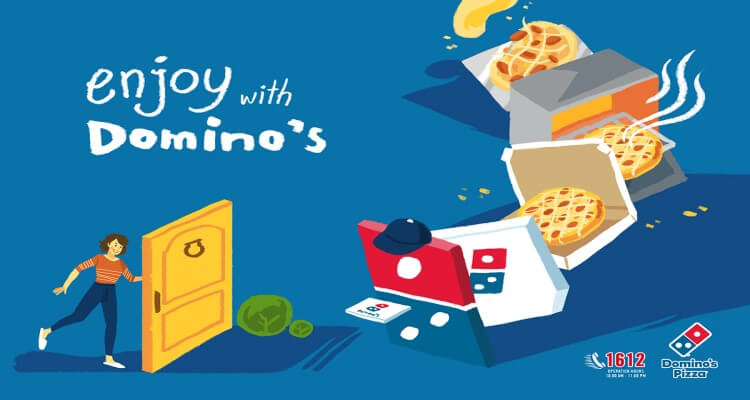Domino’s Business Model: Secrets of Domino’s marketing strategy
Domino’s business model is simple and smooth. Basically, it focuses on two key aspects: online pizza sales and franchising. Domino’s Pizza either directly sells its products through online platforms or operates a network of franchise stores to cater to its customer base. In addition, Domino’s marketing strategy also offers digital ordering with real-time tracking features. In this blog, we will know the Domino’s business model.
About Domino’s Business Model
While there are lots of fast-food companies struggling to fend off the rise of cutthroat competition, Domino’s Pizza has won millions of hearts by expanding its operations and leveraging modern technology into its operations. You might be shocked to know that Domino daily delivers more than three million pizzas across the globe on average.

Well, this does not happen overnight; it took lots of years to achieve this milestone. Hold on, today we will throw some light on how Domino’s works, its business, and its revenue model, so let’s get started. Today, Domino’s, with more than 12,500 stores across 80 locations, is earning lots of profits. Domino’s has implemented various changes and innovations, ranging from menu updates to enhancements in its pizza recipes, to attract its customers. Living in a digitally connected world, the brand has also proliferated its operations; now, users can order pizza through a dedicated app and website. In fact, more than 50% of sales come through online ordering; hence, the company has leveraged modern tech tools and also implemented voice-ordering applications.
History of Domino’s Business
Established in 1960, Domino’s Pizza was founded by two brothers in Michigan. They were working at a small restaurant and were paid $500. Later, in order to fulfil his dream, they borrowed another $900 and opened a pizza outlet named Domino’s. Later, Domino’s opened its first franchise locations in 1967 and 1978; gradually, you can see more than 1700 stores operating across the globe.
In 1983, Domino’s Pizza expanded its global presence by inaugurating its inaugural international store in Manitoba, which marked a significant milestone for the company’s international growth. Later, it continued to expand its operation across the UK and Japan.
When it completed 38 years in the pizza domain, the founder of Domino’s announced retirement and sold his 93% shares to private firm Brain Capital for $1 billion.

In 2004, the company finally went public and was listed on the New York Stock Exchange. It raised approximately $339 million through its first IPO. Domino’s Pizza remains one of the most popular pizza chains across the globe, beating its close rivals, including Pizza Hut, US Pizza, Papa John’s Pizza, and many more. Today, Domino’s operates more than 17000 locations across 85 countries, including America, Asia Pacific, Europe, the Middle East, and South Africa. As of the latest available data, Domino’s Pizza has achieved a current market valuation of approximately $11.73 billion.
How Does Domino’s Business Model Work

Domino’s business model operates using a franchisee model. The company issues “master franchise agreements” to international operators that grant large commercial entities exclusive rights to sub-franchise and develop stores. It also reserves the right for its international franchisees to operate supply chain centres in specific geographic locations. Domino’s marketing strategy generates revenue by collecting fees for each new store established and by earning royalties calculated as a percentage of sales from franchisees. Typically, those fees are around 3% of sales in international markets and lower for its US franchisee partners.
Domino’s marketing strategy
Domino’s makes money by dominating its supply chain. It sells toppings, sauces, and dough to its franchisees. It may come as a surprise that the parent company of Domino’s Pizza generates more revenue through its supply chain operations than it does from royalties on sales and franchise fees. To gain a comprehensive understanding of Domino’s business model, let’s delve into the details:
Franchise fees
Domino’s charges franchisees a 5.5% royalty fee based on sales. Considering the company ties its franchise to a 10-year contract, it’s a lucrative revenue stream. US stores contribute around 6% of sales to national marketing campaigns.
The business division accounts for just under 40% of revenue, with the company generating more than $1.3 billion in revenues from franchise fees each year.
Supply chain
The primary source of Domino’s revenue does not stem from franchise fees or the delivery of pizzas to customers’ doors. Domino’s biggest catering business accounts for nearly 60% of its annual revenues. Domino’s supply chain operates 19 dough manufacturing centres across the US and five in Canada.

The supply centres purchase, receive, store, and deliver ingredients to their franchisees, producing fresh dough for the pizza bases. Franchisees may not purchase ingredients outside of their supply chain.
Future Growth Engine
Domino’s marketing strategy expects to have plenty of runway for its growth strategy over the next decade. It is strategically focused on extending its international presence into additional global markets. While concurrently strengthening its existing international operations.
Conclusion
Domino’s business model has established itself well in its market and still maintains its products, especially pizza. Most of their customers would like to go to their outlet because they make the true decision about their target market, which is who their product will be sold to and how many segmentations they will target. The segmentation that has been used by Domino’s Pizza to provide their product and in order to create customer values consists of demographic segmentation. It is related to the age, gender, income, and occupation of the customer.


